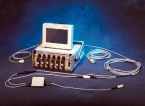The Thoratec HeartMate® XVE LVAS (vented electric) was developed and tested by Thermo Cardiosystems, Inc. and the Texas Heart Institute. In 1991, the system was implanted in a patient who was subsequently supported for 505 days. This patient, who was able to leave the hospital while being supported by this device, paved the way for other patients to routinely wait at home for their transplants. Because the system is relatively easy to use, patients and their families can maintain it outside the hospital setting. Patients can live at home, return to work, and resume a more normal lifestyle while awaiting a suitable donor heart. Recently, the Food and Drug Administration (FDA) approved the HeartMate XVE LVAS for destination therapy, which means the device can be used as permanent support for end-stage heart failure patients not eligible for heart transplants.
The Pump
 This titanium blood pump consists of a blood chamber, a motor chamber, a drive-line, and inflow and outflow conduits. The pump weighs 1150 grams. Each conduit contains a 25-mm porcine (pig) valve within a woven Dacron™-fabric graft. A polyurethane diaphragm separates the blood chamber and the motor chamber. Textured surfaces within the blood chamber promote the development of a cellular lining, which helps prevent blood clots and infection. The XVE LVAS has a maximum stroke volume of 83 milliliters. It can be operated at up to 120 beats per minute, resulting in flow rates of up to 10 liters per minute.
This titanium blood pump consists of a blood chamber, a motor chamber, a drive-line, and inflow and outflow conduits. The pump weighs 1150 grams. Each conduit contains a 25-mm porcine (pig) valve within a woven Dacron™-fabric graft. A polyurethane diaphragm separates the blood chamber and the motor chamber. Textured surfaces within the blood chamber promote the development of a cellular lining, which helps prevent blood clots and infection. The XVE LVAS has a maximum stroke volume of 83 milliliters. It can be operated at up to 120 beats per minute, resulting in flow rates of up to 10 liters per minute.
External Equipment
 The XVE LVAS external equipment includes a system controller, a power base unit, and a 20-foot power cable, as well as batteries and other accessories. The system controller continuously monitors and controls the implanted motor and shows information regarding alarm conditions.
The XVE LVAS external equipment includes a system controller, a power base unit, and a 20-foot power cable, as well as batteries and other accessories. The system controller continuously monitors and controls the implanted motor and shows information regarding alarm conditions.
The power base unit serves as a battery charger and as an interface between the system monitor and the implanted pump. The 20-foot power cable allows the system to be operated by AC power. Alternatively, patients can wear a portable battery pack around their waist, which permits the system to be operated tether-free for up to 8 hours.
For more information, you can read "Multicenter Clinical Evaluation of the HeartMate Vented Electric Left Ventricular Assist System in Patients Awaiting Heart Transplantation," which appears in Volume 122 (2001) of the Journal of Thoracic and Cardiovascular Surgery (pp. 1186-1195), and "Long-term Use of a Left Ventricular Assist Device for End-Stage Heart Failure," which appears in Volume 345 (2001) of the New England Journal of Medicine (pp.1435-1443).



